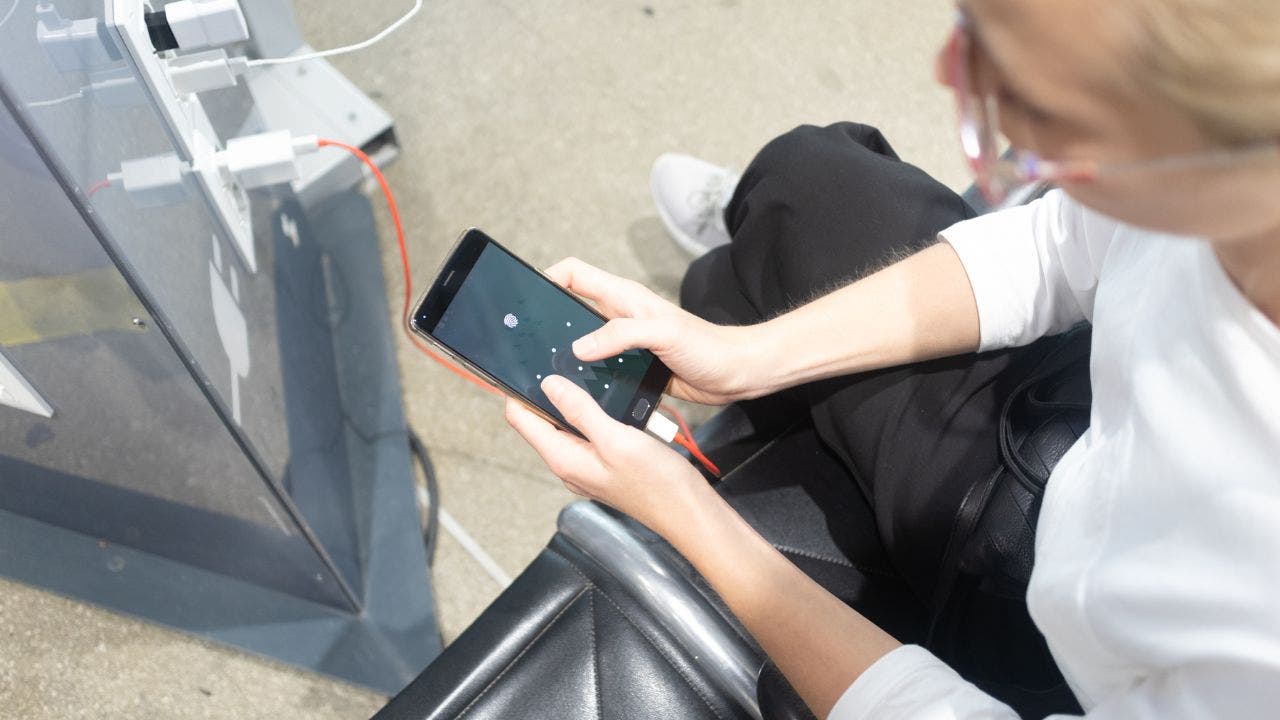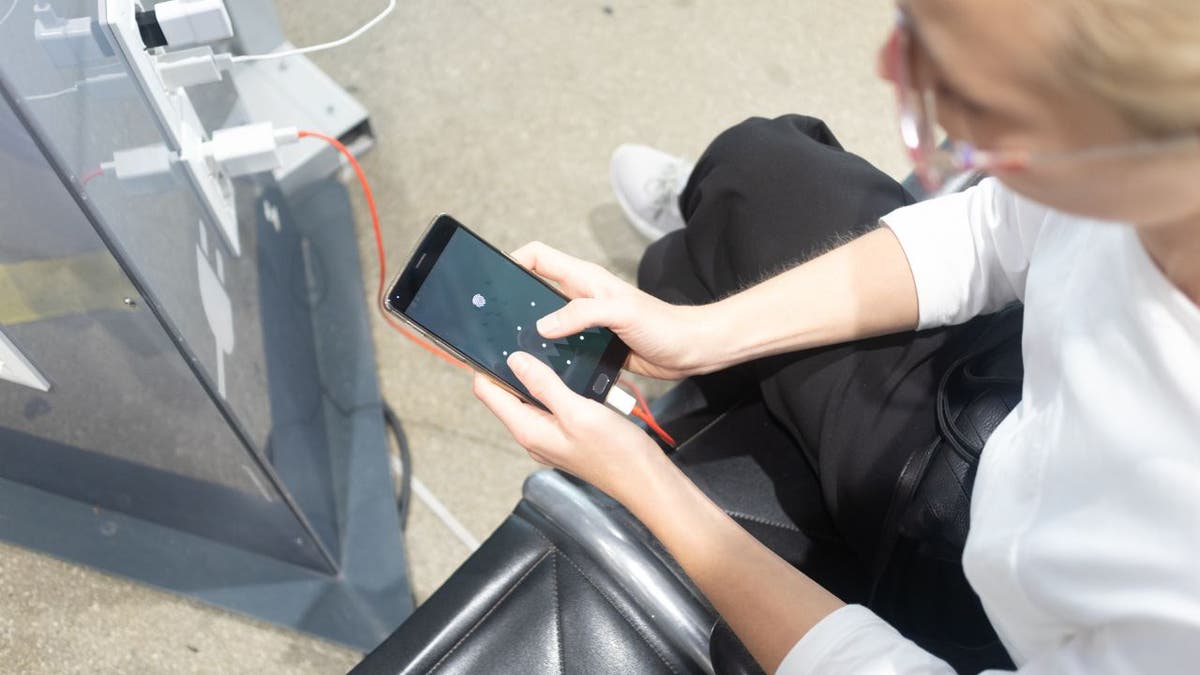At this point, it’s pretty clear what Donald Trump wants from Mark Zuckerberg. But what does Zuckerberg, who has now gone to Mar-a-Lago twice since the November election, want from the President-elect?
Technology
Travel season is here: 7 tips and tricks from a tech and traveling pro

I’ve been to 32 different countries, and let me tell you, travel can be stressful. But a little know-how and planning can make your getaway more relaxing than worrisome.
We’re giving away a $799 iPhone 15. Enter to win now!
Stick to sites you know and trust
I’M A TECH EXPERT AND YOU NEED TO MAKE THESE TECH CHANGES NOW BEFORE IT’S TOO LATE
Crooks are great at creating fake travel apps and sites to rip you off — and AI tools make it even easier to whip them up. Fortunately, there are signs to watch for that can help you avoid them.
- Check official resources: The Better Business Bureau can be a great aid in determining whether a business is legit. The agency lists real companies; if you can’t find the one you’re working with, it’s best to run away.
- Online reviews and ratings: Read online reviews and ratings on sites like TripAdvisor, Yelp or Google. Incredibly positive and negative reviews could be bogus. Watch for a balance of reviews and consistent themes.
- Accreditation and licensing: Many legitimate travel agencies are members of recognized industry organizations like the American Society of Travel Advisors (ASTA) or have IATA (International Air Transport Association) accreditation. Check for credentials on their site.
- Transparent pricing: Legitimate sites are clear and upfront about all costs. Beware of sites that have hidden fees or don’t clearly explain costs.
- Secure payment options: Reputable travel sites offer secure, well-known payment options. Be wary of sites that only allow bank transfers or money orders.
Speaking of, I recently took a fantastic trip to Japan. Watch my travel tips on YouTube. You’ll definitely want to put this on your bucket list!
Keep track of your bag
Lost luggage can ruin your trip. Many major airlines (including United, American, Delta and Air New Zealand) allow you to track your luggage in real time through the airline’s official app, so download it before you hit the road.
Travelers with luggage use smartphones while waiting in line for boarding at an airport. (iStock)
Pro tip: Searching the app stores can lead you to copycats. Go to your airline’s official website and look for a link to the app in the header or footer.
I throw an Apple AirTag in checked bags for extra peace of mind.
- Apple’s AirTags are ideal for an iPhone, Mac or iPad.
- The Tile Essentials 4-pack comes with various tags for your keys, wallet, luggage or whatever else you want to try. Nice option for Android.
Set your Gmail and Drive to offline mode.
Sometimes, the connection is so bad you can’t even load your inbox. Lucky you, you can still get your replies all queued up if you plan.
In Gmail on your desktop:
- Hit the settings cog > See all settings.
- Choose the Offline tab, then check the box next to Enable offline mail.
- From here, choose how many days of messages you want to sync.
- Click Save changes.
FIX AUTOCORRECT IF IT’S DRIVING YOU DUCKING CRAZY
Now, do the same for your most-used documents in Google Drive. You need to do this for each document, so be sure to take care of it ahead of time.
First, enable the setting:
- Open Google Drive.
- At the top right, click the settings cog > Settings.
- Turn on Offline.
Depending on your storage, recent files will be automatically saved offline. To manually select files:
- On the file you want to use, hit File > Make available offline.
Score, in-flight Wi-Fi! Before you start browsing …
Most of us see a network name that looks about right and click it without much thought. That’s what hackers are banking on! Crooks can create fake Wi-Fi networks with almost identical names to the airline’s. If you’re not careful, you could plug into a copycat network instead of the legit one.
If multiple options look similar, ask a member of the airline staff which network is the right one. Hey, they may even give an in-air PSA if you spot a fake.

A Wi-Fi and fasten seat belts sign illuminated on a Delta Air Lines plane at Raleigh-Durham International Airport (RDU) in Morrisville, North Carolina, U.S., on Thursday, Jan. 20, 2022. (Al Drago/Bloomberg via Getty Images)
Oh, and switch on a VPN
Normally, what you do on the internet is open for anyone with the right know-how to peek in on. A VPN (Virtual Private Network) encrypts your data — acting as a shield from prying eyes. VPNs aren’t quite as reliable in the air, but it’s still worth switching on.
Not optional if you’re visiting any site that contains financial or other identifying, important information.
Double-check your AirDrop settings
I got a strange picture sent to my phone at the airport once. I looked around and saw the snickering teenagers. Yeah, it was funny — but not every prank is innocent.
Keyloggers keep track of every single thing you type, and criminals love to pass them along using Apple’s AirDrop feature. Don’t accept drops from strangers in flight.
On your iPhone:
- Go to Settings > General > AirDrop.
CHARGING AND TRAVEL: 5 MALWARE MISTAKES MOST PEOPLE MAKE
You can set your phone to reject all AirDrop requests, only allow them from contacts or allow from everyone. (That last one is not the best idea for travel.)
On a Mac:
- Click Control Center in the menu bar (it’s the icon with two toggles).
- Click AirDrop. From here, you can turn it on or off and choose who can send items.
Your phone is worth a lot
It’s way more valuable than just the amount someone could sell it for. (Though that’s a pretty enticing amount if you have a newer phone.) Think about all the accounts connected to it: your bank and other financial apps, email inbox and private text messages containing who knows what.
- When you’re out in public, shield your PIN. If you really need to open your phone in front of people, use Face ID or your fingerprint.
- Don’t use an easy PIN, either. No four digits! Make it as long as you can remember.
- If you don’t want to use Face ID, use a passcode with numbers and letters if your phone allows it.

A view of someone charging their phone in a public area. (Fox News)
Get tech-smarter on your schedule
Award-winning host Kim Komando is your secret weapon for navigating tech.
Copyright 2024, WestStar Multimedia Entertainment. All rights reserved.

Technology
What does Mark Zuckerberg want from Donald Trump?
/cdn.vox-cdn.com/uploads/chorus_asset/file/25822588/STK169_ZUCKERBERG_MAGA_STKS491_CVIRGINIA_B.jpg)
That’s the question I’ve been asking sources in and around Meta over the last several days. They all described Meta’s relationship with the outgoing Biden administration as incredibly hostile. It’s safe to assume that Zuckerberg wants a reset for the MAGA regime, especially since Trump threatened not that long ago to imprison him for life.
In Trump’s America, removing tampons from the mens’ restrooms on Meta’s campuses, — a real thing that just happened — is as much a business decision as a political one. Destroying ‘woke’ ideology is a key pillar of Trump’s stated mandate. Others who know they need to play the game, like Amazon, are also starting to fall in line. Even still, Zuckerberg is transforming Meta for this new political reality at a speed that’s unusual for a company of its size and influence. Founder mode.
In his conversation with Joe Rogan and his video on Instagram, Zuckerberg shares a laundry list of issues that Trump could help him with: fighting other countries that are ratcheting up their policing of his platforms, stopping Apple from dictating how he builds mobile apps and smart glasses (the latter is increasingly important to Meta’s future), and, perhaps most importantly, keeping domestic AI regulation from slowing his efforts to crush OpenAI. Elon Musk has bought Trump’s ear. But the more time Zuckerberg spends in Mar-a-Lago, the more Sam Altman and Tim Cook should be worried.
Then there’s the US government’s case to break up Meta that’s set to go to trial in a few months. After the blur that was the last four years, it’s easy to forget that this lawsuit was filed at the end of Trump’s first term by a Republican FTC chair, not Lina Khan…
Most of the headline reactions from the past week have focused on Zuckerberg’s decision to end Meta’s third-party fact check program. It was a convenient scapegoat for company executives that, frankly, never lived up to the goal of bringing more neutrality to Facebook and Instagram. The Community Notes alternative Meta is cribbing from X was not on the product roadmap before this week, so it will probably be awhile before everyone sees it in the wild.
The announcement that US moderators would be moved from California to Texas is perhaps the most cynical of them all; talk to anyone who knows and they’ll tell you the vast majority of moderators are already based in Austin.
The hateful speech that is now allowed on Meta’s is eye-popping on its face and will be deserving of more scrutiny in the coming weeks. The decision to start recommending political content again is a 180-degree turn for Zuckerberg. But insiders believe that the most impactful change for users of Meta’s apps will be the softening of its systems that remove content for potential policy violations.
Out of all the announcements Meta made last week, this is the one I believe is the least connected to Trump. Meta execs have been signaling for a while that they know they are mistakenly removing too much content that doesn’t actually break the rules; I’m told it’s one of, if not the, biggest complaint in user surveys. If done correctly, dialing back on moderation mistakes may be the only thing Zuckerberg announced that makes everyone happy.
Elsewhere
- CES is for dealmaking now: Each year, the official CES show — the sprawling show floor and flashy keynotes — feels more like an advertising exercise and no longer a place to launch real products. Most of the energy has moved to private meeting rooms and happy hours at the Wynn, Aria, and Cosmopolitan, where tech execs are schmoozing CMOs and getting deals done with partners all week. At this shadow CES, everyone seems to agree that the show is more alive than ever. Booths on the show floor have become marketing tools to show clients before you take them to a steak dinner. The challenge for the organizers of CES will be figuring out how to bridge the growing influence of this part of the show with their current business model of charging people to walk around booths filled with smart toasters and concept cars.
- TikTok may just get banned: Imagine an alternate world in which the Chinese government is about to ban Instagram from operating in the country and Mark Zuckerberg is in hiding. That’s the situation with ByteDance and its founder Zhang Yiming, who stepped down from the CEO role after the last US ban attempt but still controls the company. He let TikTok be banned in India and seemingly has no interest in the app surviving this time, so why wouldn’t he let the same thing happen again?
- Google and OpenAI flick at what’s next: Google’s DeepMind unit is starting “an ambitious project to build generative models that simulate the physical world,” which it believes “is on the critical path to artificial general intelligence.” Meanwhile, OpenAI is returning to its early roots by starting a “general-purpose robotics” team that will build hardware and push “towards AGI-level intelligence in dynamic, real-world settings.” We may have hit a scaling wall on text data but the big labs clearly see an opportunity in 3D. (See also what Nvidia announced last week.)
- Other headlines you may have missed: Tencent (a large investor in Epic Games, Snap, and US tech companies) was put on the Pentagon’s blacklist for being allegedly under the influence of the Chinese military. Tim Cook’s total compensation rose 18 percent last year to $74.6 million. Elon Musk is hosting an inauguration party for Trump in DC with Uber and The Free Press. Sam Altman’s sister filed a sexual abuse lawsuit against him.
Job board
Some recent, noteworthy job changes in the tech world:
- A bunch of changes at Meta: UFC CEO Dana White, Exor CEO John Elkann, and Charlie Songhurst joined the board. Joel Kaplan is running policy and comms now. After a stint at Google, I’m told Michael Levinson is coming back as VP of product for the Integrity org. (Good luck!) Head of civil rights, Roy Austin, is leaving. And former DEI chief Maxine Williams is now head of “accessibility and engagement.”
- Elon Musk’s X named a couple of new leaders: Romina Khananisho is the new head of government affairs and John Nitti is head of “ad innovation.”
- Calista Redmon joined Nvidia as VP of “global AI initiatives,” where she’ll “drive adoption of the NVIDIA platform for national and regional AI initiatives.”
- Sophia Dominguez, Snap’s director of AR platform, is leaving.
More links
If you haven’t already, don’t forget to subscribe to The Verge, which includes unlimited access to Command Line, all of our reporting, and an improved ad experience on the web.
As always, I want to hear from you, especially if you work at Meta. Respond here, and I’ll get back to you, or ping me securely on Signal.
Technology
PowerSchool data breach exposes millions of student and teacher records

Cybercriminals spare no industry, targeting sectors like health care, insurance, automotive and education. Health care has been a frequent target, with attacks like the Ascension breach last year and the CVR incident in late 2024.
Now, education technology giant PowerSchool has become the latest target, with records of millions of students and teachers stolen.
While the exact number of affected individuals remains unknown, the scale of the breach is alarming.
PowerSchool serves 18,000 customers worldwide, including schools in the U.S. and Canada, managing grading, attendance and personal information for over 60 million K-12 students and teachers.
I’M GIVING AWAY THE LATEST & GREATEST AIRPODS PRO 2
Kids working on their laptops (Kurt “CyberGuy” Knutsson)
How did hackers target PowerSchool
PowerSchool revealed a cybersecurity breach to its customers Jan. 7, as reported by BleepingComputer. The company said it discovered the breach Dec. 28, after customer data from its PowerSchool SIS platform was stolen through the PowerSource support portal.
PowerSchool SIS is a student information system used for managing grades, attendance, enrollment and other student records. Hackers accessed the PowerSource portal using stolen credentials and used an “export data manager” tool to steal information.
The company said this wasn’t a ransomware attack or a result of software flaws, but rather a straightforward network break-in. The company has hired a third-party cybersecurity firm to investigate the breach, figure out what happened and determine who was affected.

Illustration of a hacker at work (Kurt “CyberGuy” Knutsson)
UNDERSTANDING BRUSHING SCAMS AND HOW TO PROTECT YOURSELF
What data got stolen
The PowerSource portal includes a feature that allows PowerSchool engineers to access customer systems for support and troubleshooting. The attacker exploited this feature to export the PowerSchool SIS “students” and “teachers” database tables to a CSV file, which was then stolen.
PowerSchool confirmed the stolen data primarily includes contact details like names and addresses. However, for some districts, the data may also include sensitive information such as Social Security numbers, personally identifiable information, medical records and grades.
WHAT IS ARTIFICIAL INTELLIGENCE (AI)?
The company said customer support tickets, credentials and forum data were not accessed or stolen during the breach. PowerSchool also emphasized that not all SIS customers were affected and expects only a subset of customers will need to notify those affected.
“We do not anticipate the data being shared or made public, and we believe it has been deleted without any further replication or dissemination,” the developer told customers in a notice.
“We have also deactivated the compromised credential and restricted all access to the affected portal. Lastly, we have conducted a full password reset and further tightened password and access control for all PowerSource customer support portal accounts.”
PowerSchool said affected adults will be offered free credit monitoring, while minors will receive subscriptions to an unspecified identity protection service.

Illustration of a hacker at work (Kurt “CyberGuy” Knutsson)
MASSIVE DATA BREACH EXPOSES 3 MILLION AMERICANS’ PERSONAL INFORMATION TO CYBERCRIMINALS
5 ways you can stay safe from PowerSchool data breach
The PowerSchool data breach has highlighted the importance of staying vigilant about your personal information. Here are five steps you can take to protect yourself:
1. Monitor your accounts regularly: Keep a close eye on your bank accounts, credit cards and any online services linked to your personal information. Watch for unauthorized transactions or changes to your accounts that could signal misuse of your data.
2. Freeze your credit: If your Social Security number or other sensitive details were compromised, consider placing a credit freeze with major credit bureaus like Equifax, Experian and TransUnion. This prevents potential identity thieves from opening new accounts in your name.
3. Use identity theft protection services: Take advantage of any identity protection services offered by PowerSchool as part of its breach response. These services can alert you to suspicious activity and provide support if your identity is stolen.
One of the best parts of some identity protection services is that they have identity theft insurance of up to $1 million to cover losses and legal fees and a white glove fraud resolution team where a U.S.-based case manager helps you recover any losses. See my tips and best picks on how to protect yourself from identity theft.
4. Enable two-factor authentication (2FA): Wherever possible, enable 2FA for your online accounts. This adds an extra layer of security by requiring a second form of verification, such as a text code or app-generated token, to access your accounts.
5. Be aware of phishing links and use strong antivirus software: Cybercriminals often use phishing scams to exploit data breaches. Avoid clicking on suspicious links in emails or text messages, especially those claiming to be from PowerSchool or your school district.
The best way to safeguard yourself from malicious links is to have antivirus software installed on all your devices. This protection can also alert you to phishing emails and ransomware scams, keeping your personal information and digital assets safe. Get my picks for the best 2025 antivirus protection winners for your Windows, Mac, Android and iOS devices.
WINDOWS FLAW LETS HACKERS SNEAK INTO YOUR PC OVER WI-FI
Kurt’s key takeaway
You can blame hackers for this breach, but PowerSchool shares the responsibility for failing to adequately protect sensitive data. The company may also be in violation of data privacy agreements it signed with school districts, as well as federal and state laws designed to safeguard student privacy. What’s more concerning is that PowerSchool took nearly two weeks to notify its customers about the breach. Schools are now left scrambling to assess the full extent of the intrusion. This delay is not just irresponsible; it puts students, parents and teachers at heightened risk of cyberattacks and identity theft.
Do you think companies like PowerSchool should face stricter regulations for handling sensitive data? Let us know by writing us at Cyberguy.com/Contact
For more of my tech tips and security alerts, subscribe to my free CyberGuy Report Newsletter by heading to Cyberguy.com/Newsletter
Ask Kurt a question or let us know what stories you’d like us to cover
Follow Kurt on his social channels
Answers to the most asked CyberGuy questions:
New from Kurt:
Copyright 2025 CyberGuy.com. All rights reserved.
Technology
L’Oréal’s new skincare gadget told me I should try retinol
/cdn.vox-cdn.com/uploads/chorus_asset/file/25826211/lorealcellbioprint.jpg)
Las Vegas is punishingly dry. The arid winter air means I woke up on Day 3 of CES 2025 with a nosebleed, chapped lips, and ashy legs. This in spite of the fact I slathered myself with two pumps of a fermented bean essence, eye cream, moisturizer, and a lip mask. Staring at my face in the hotel mirror, I wonder if any of those products were doing what they’re supposed to — and if maybe, I should try something different.
This is why I was so eager to try L’Oréal’s Cell BioPrint.
For anyone who’s struggled with their complexion, the Cell BioPrint feels like a holy grail gadget. The device is a mini-lab setup that analyzes a skin sample to generate a report about your skin’s current condition. It’ll also “grade” your skin with regard to oiliness, wrinkles, skin barrier function, pore size, and uneven skin tone. Based on the proteins in your skin, you’ll also see whether you’re more likely to be susceptible to those issues down the line — even if they aren’t issues now. The test also determines whether you’re responsive to retinol, a popular and well-studied skincare ingredient that nevertheless causes a ton of confusion online.
In my demo, using the Cell BioPrint was simple. Mainly because I didn’t have to do a thing. While L’Oréal hopes to one day make Cell BioPrint an at-home device, it’ll first be aimed at retail, dermatology offices, and skincare clinics. As in, the actual test will be done by a professional to ensure accuracy. A L’Oréal staffer collected a sample from both my cheeks using a special kind of sticker. I watched as he then dissolved it in a buffer liquid, placed the resulting solution into a cartridge, and fed that cartridge into a machine. I also had my cheeks and forehead scanned with an imaging wand before answering two questions about my age and demographic data.
After a few minutes, I got to see my results. Apparently, I’m doing something right because the report said that my chronological and biological age were aligned. But it also said that while my skin barrier function is currently good, I’m biologically prone to have issues with that as I get older. My report also said that I don’t have to be concerned with pore size — either now or in the future, and that I am highly responsive to retinol, meaning my skin is likely to tolerate it well.
There were several other insights I won’t bore you with, but after going over my results, I have a better sense of what I need to focus on. For instance, I should continue using moisturizers with ceramides, button up my sun care habits outside of sunscreen, add a vitamin C to help with my skin tone, and add a retinol. I also know what I don’t need or can remove from my routine. For example, I don’t need to buy products targeted toward shrinking pores.
Most of this wasn’t surprising. My results aligned with the concerns I’ve noticed and where I tend to concentrate my skincare routine. For example, the few times I’ve tried retinol, I’ve never had an hint of the sensitivities other people seem to experience.
Of course, this kind of personalized recommendation is only as good as the science behind it. After all, lots of health and beauty tech companies promise the moon, but are intentionally coy when it comes to explaining why you should trust them. Barring regulatory certification (which isn’t generally required for wellness and beauty tech), it’s left up to the individual to try to discern whether an explanation passes the smell test.
With that in mind, I asked L’Oréal to dive deep into the science — which Guive Balooch, global vice president of L’Oréal’s Technology Incubator, happily obliged.
Balooch says the company had 800 biologists working (and publishing clinical studies) to discover whether there are specific proteins expressed in skin cells that could determine your risk factors for certain skin conditions. The challenge, he says, is that there are a lot of proteins produced by the body. Finding the few out of the thousands that can give actionable skincare insights is like finding a handful of needles in a giant haystack. It required L’Oréal’s researchers to sequence all of them and then find the relevant biomarkers.
This particular branch of research, Balooch says, is called proteomics — or the study of how proteins are expressed in the body. “It’s understanding that our cells every day are making proteins. Depending on our lifestyle, our geography, and our genes, they will make more or less of these proteins. It changes over time and habits can change it as well.”
Balooch says L’Oréal tested 4,000 people over 10 years across the US, Europe, South America and Asia, and found five proteins related to skin health, including two that are related to how well a person’s skin will respond to retinol. And while the Cell BioPrint can only currently analyze responsiveness to retinol, other ingredients like niacinamide and hyaluronic acid are also in the works.
“In some ways, it’s meant to tell people what not to buy.”
Cynically speaking, a device like this could also be viewed as a pseudoscientific way to sell more products to a group of people already prone to reach for their wallets. But Balooch argues the Cell BioPrint isn’t meant to encourage people to buy more.
“In some ways, it’s meant to tell people what not to buy,” he says. “Of course, we would love to sell more products, but not by overconsumption. That’s not actually good for your skin. It’s about helping people find the right products based on science.”
To that end, Balooch has a point. The skincare market right now is rife with misinformation and influencers pushing expensive 10-step routines that sometimes do more harm than good. I know better, and yet I’m as guilty as the next skincare nerd. (I’m still haunted by the full bottle of snail mucin influencers claimed would fix all my problems. It broke me out instead.) Even now, I know that I’ll probably get influenced again. The difference is at least I can choose to be influenced towards a retinol cream or vitamin C serum — things that have a higher chance of helping me — rather than throwing my money to the wind.
-

 Politics1 week ago
Politics1 week agoCarter's judicial picks reshaped the federal bench across the country
-

 Politics1 week ago
Politics1 week agoWho Are the Recipients of the Presidential Medal of Freedom?
-

 Health1 week ago
Health1 week agoOzempic ‘microdosing’ is the new weight-loss trend: Should you try it?
-

 World1 week ago
World1 week agoSouth Korea extends Boeing 737-800 inspections as Jeju Air wreckage lifted
-
/cdn.vox-cdn.com/uploads/chorus_asset/file/25822586/STK169_ZUCKERBERG_MAGA_STKS491_CVIRGINIA_A.jpg)
/cdn.vox-cdn.com/uploads/chorus_asset/file/25822586/STK169_ZUCKERBERG_MAGA_STKS491_CVIRGINIA_A.jpg) Technology4 days ago
Technology4 days agoMeta is highlighting a splintering global approach to online speech
-

 News1 week ago
News1 week agoSeeking to heal the country, Jimmy Carter pardoned men who evaded the Vietnam War draft
-

 Science1 day ago
Science1 day agoMetro will offer free rides in L.A. through Sunday due to fires
-

 News1 week ago
News1 week agoTrump Has Reeled in More Than $200 Million Since Election Day















